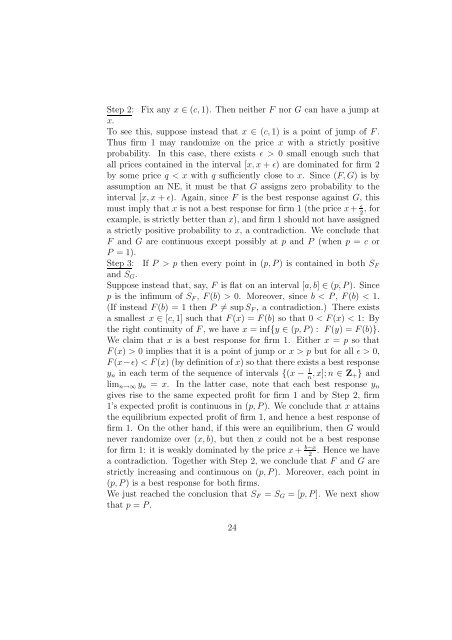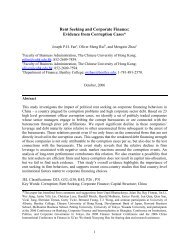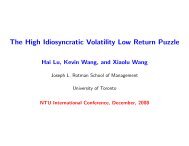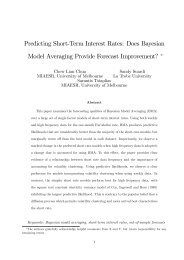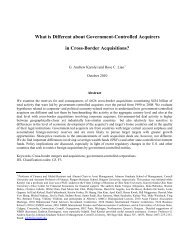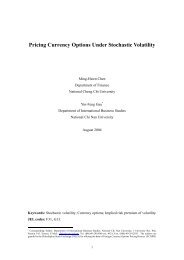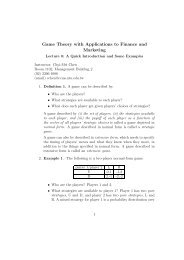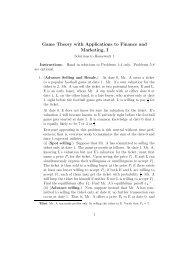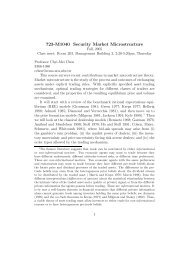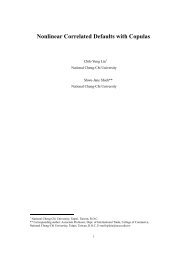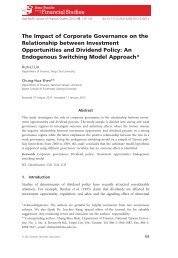Game Theory with Applications to Finance and Marketing
Game Theory with Applications to Finance and Marketing
Game Theory with Applications to Finance and Marketing
You also want an ePaper? Increase the reach of your titles
YUMPU automatically turns print PDFs into web optimized ePapers that Google loves.
Step 2: Fix any x ∈ (c, 1). Then neither F nor G can have a jump atx.To see this, suppose instead that x ∈ (c, 1) is a point of jump of F .Thus firm 1 may r<strong>and</strong>omize on the price x <strong>with</strong> a strictly positiveprobability. In this case, there exists ɛ > 0 small enough such thatall prices contained in the interval [x, x + ɛ) are dominated for firm 2by some price q < x <strong>with</strong> q sufficiently close <strong>to</strong> x. Since (F, G) is byassumption an NE, it must be that G assigns zero probability <strong>to</strong> theinterval [x, x + ɛ). Again, since F is the best response against G, thismust imply that x is not a best response for firm 1 (the price x + ɛ, for 2example, is strictly better than x), <strong>and</strong> firm 1 should not have assigneda strictly positive probability <strong>to</strong> x, a contradiction. We conclude thatF <strong>and</strong> G are continuous except possibly at p <strong>and</strong> P (when p = c orP = 1).Step 3: If P > p then every point in (p, P ) is contained in both S F<strong>and</strong> S G .Suppose instead that, say, F is flat on an interval [a, b] ∈ (p, P ). Sincep is the infimum of S F , F (b) > 0. Moreover, since b < P , F (b) < 1.(If instead F (b) = 1 then P ≠ sup S F , a contradiction.) There existsa smallest x ∈ [c, 1] such that F (x) = F (b) so that 0 < F (x) < 1: Bythe right continuity of F , we have x = inf{y ∈ (p, P ) : F (y) = F (b)}.We claim that x is a best response for firm 1. Either x = p so thatF (x) > 0 implies that it is a point of jump or x > p but for all ɛ > 0,F (x−ɛ) < F (x) (by definition of x) so that there exists a best responsey n in each term of the sequence of intervals {(x − 1 , x]; n ∈ Z n +} <strong>and</strong>lim n→∞ y n = x. In the latter case, note that each best response y ngives rise <strong>to</strong> the same expected profit for firm 1 <strong>and</strong> by Step 2, firm1’s expected profit is continuous in (p, P ). We conclude that x attainsthe equilibrium expected profit of firm 1, <strong>and</strong> hence a best response offirm 1. On the other h<strong>and</strong>, if this were an equilibrium, then G wouldnever r<strong>and</strong>omize over (x, b), but then x could not be a best responsefor firm 1: it is weakly dominated by the price x + b−x . Hence we have2a contradiction. Together <strong>with</strong> Step 2, we conclude that F <strong>and</strong> G arestrictly increasing <strong>and</strong> continuous on (p, P ). Moreover, each point in(p, P ) is a best response for both firms.We just reached the conclusion that S F = S G = [p, P ]. We next showthat p = P .24


